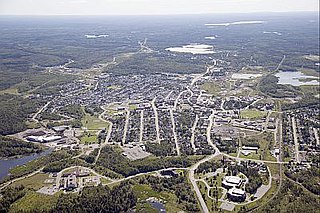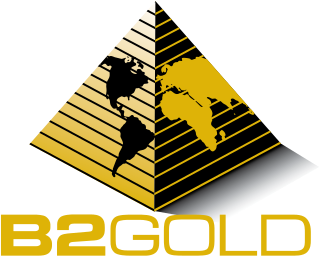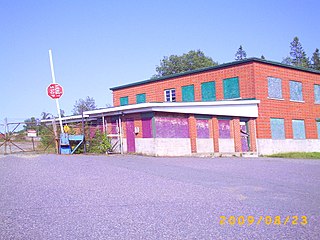Related Research Articles

Kirkland Lake is a town and municipality in Timiskaming District of Northeastern Ontario. The 2016 population, according to Statistics Canada, was 7,981.

Agnico Eagle Mines Limited is a Canadian-based gold producer with operations in Canada, Finland and Mexico and exploration and development activities extending to the United States. Agnico Eagle has full exposure to higher gold prices consistent with its policy of no-forward gold sales. As of 2017, it has paid a cash dividend every year since 1983.

Eldorado Gold Corporation is a Canadian company that owns and operates gold mines in Turkey, Greece and Canada. Since its merger with European Goldfields in 2011 the company has been pursuing the development of the Skouries mine, Olympias mine and Stratoni mine in Greece. The company previously developed and operated gold mines in China, Brazil and Mexico. Headquartered in Vancouver and listed on the Toronto and New York Stock Exchanges, Eldorado Gold has developed and operated assets from several merged companies HRC Developments Corporation, Afcan Mining Corporation, Sino Gold Mining, Brazauro Resources, Integra Gold, as well as European Goldfields.
Yamana Gold Inc. is a Canadian company that owns and operates gold, silver and copper mines in Canada, Chile, Brazil and Argentina. Headquartered in Toronto, the company was founded in 1994 and became listed on the Toronto Stock Exchange in 1995, the New York Stock Exchange in 2007, and the London Stock Exchange in 2020. The company became a gold producer after its 2003 re-restructuring in which Peter Marrone took over as chief executive officer and it merged with Brazilian company Santa Elina Mines Corporation. The combined company was able to use Yamana's access to capital with Santa Elina development properties to bring the Chapada mine into production. From there the company combined with other TSX-listed companies RNC Gold, Desert Sun Mining, Viceroy Exploration, Northern Orion Resources, Meridian Gold, Osisko Mining and Extorre Gold Mines which each contributed either a producing mine or a development project that was able to come into commercial production.
Iamgold Corporation is a Canadian company that owns and operates gold mines in Burkina Faso, Suriname and Canada. Headquartered in Toronto, the company was incorporated in 1990, and went public on the Toronto Stock Exchange in 1996, with additional shares being listed on the New York Stock Exchange beginning in 2005. The company formerly owned or had stakes in the Sadiola and Yatela gold mines in Mali, the Mupane gold mine in Botswana, the Niobec niobium mine in Quebec, as well as a royalty in the Diavik Diamond Mine.
There are different methods by which gold mining companies are ranked. One is by their annual production. Another is by their cash cost per ounce, that is, how much money it costs them to mine the gold. Since gold prices are the same everywhere, companies with lower costs per ounce make more profit. The most common method lists by market capitalization which considers the total value of capital holdings by that company. Also considered when comparing companies is their market capitalization per ounce of gold equivalent which takes the market value and total reserves and resources for each company as well as the price of gold into consideration. The figures for each company can be used to determine the value the stock market gives to each company's reserves on an ounce to ounce basis.
The Canadian Malartic Corporation is a mining company that operates the Malartic mine near Malartic, Quebec. Prior to 2014 the company was a public company named Osisko Mining Corporation with shares listed on the Toronto Stock Exchange and New York Stock Exchange. In 2014, Osisko Mining was subject to a hostile takeover bid by Goldcorp but an alternative bid by white knights Yamana Gold and Agnico Eagle Mines Limited was accepted that, in addition to offering a higher price, created the spin-off Osisko Gold Royalties and turned Osisko Mining Corporation into the subsidiary company Canadian Malartic Corporation jointly owned by Yamana Gold and Agnico Eagle. From its founding in 1982 until 2006, Osisko Mining bought and sold mineral exploration rights in Quebec, conducting exploration work. The company acquired an interest in the Canadian Malartic property in 2004 and after promising feasibility studies the mine was constructed with commercial production achieved in May 2011.is a Canadian company engaged in the exploration and development of several mineral properties in Quebec.

The Abitibi gold belt is a region of Canada that extends from Wawa, Ontario to Val-d'Or, Quebec. Located within the mineral-rich Abitibi greenstone belt, the gold belt is an established gold mining district having produced over 100 mines, and 170 million ounces of gold since 1901. Timmins, a town founded in 1912 following the Porcupine Gold Rush and subsequent creation of the Hollinger Mines, McIntyre Mines and Dome Mine, which was one area in the region that experienced a gold rush, beginning in 1909. The Kerr Addison Mine in Virginiatown was at one time Canada's largest gold producing mine. Many of the towns readily acknowledge gold mining as part of their history, some being named after gold. One of Canada's 'large roadside attractions' is a 12-foot replica of a 1908 gold sovereign built to commemorate Canada's first gold coin which was made using gold from the Kerr Addison owned Kerr-Addison mine.
Sandstorm Gold Ltd. is a Canadian company that provides funding to mining companies in exchange for royalties, principally in the form of net smelter returns and streams. The company focuses on precious metals but did spin off Sandstorm Metals & Energy Ltd. in 2010 as a separate TSX Venture Exchange-listed company to make volumetric production payment transactions in the base metal and fossil fuel sectors, then bought it back in 2014. Sandstorm Gold graduated from the TSX Venture Exchange to the Toronto Stock Exchange and began listing shares on the New York Stock Exchange in 2012.
New Gold Inc. is a Canadian mining company that owns and operates the New Afton gold-silver-copper mine in British Columbia and the Rainy River gold-silver mine in Ontario, Canada. Through a Mexican subsidiary company, they also own the Cerro San Pedro gold-silver mine in San Luis Potosí, Mexico, which ceased operation in 2017. While New Gold was founded in 1980 for the purposes of mineral exploration, the company became a mine operator with its merger of Peak Gold and Metallica Resources in 2008. A fourth company, Western Goldfields, joined in 2009. Together they operated the Peak mine in Australia and Mesquite Mine in California but sold both in 2018. Headquartered in Toronto, shares of the company are traded on the Toronto Stock Exchange and NYSE American.
Detour Gold Corporation is a former Canadian gold mining company, between 2006 and 2020, that owned and operated the Detour Lake Mine in the Abitibi gold belt of northeastern Ontario. Located northeast of Timmins and Cochrane, Ontario, near the Quebec border, the mine was operated by Placer Dome between 1983 and 1999, recovering 1.8 million ounces of gold in that time, and maintained as an exploration property by Pelangio Mines Inc. until 2006 when a group of investors formed the Detour Gold Corporation to develop a new mine. An initial public offering on the Toronto Stock Exchange on January 31, 2007, as well as several subsequent offerings, raised sufficient funds to develop the mine, so that it began production in 2013. Its low grade concentrations necessitated an open pit mine with cyanidation and carbon in pulp processing. Between 2014 and 2019 the mine produced between 500,000 and 600,000 ounces of gold each year. In 2020, following a proxy fight with activist shareholder Paulson & Co., the mine and the company were acquired by Kirkland Lake Gold in an all-stock purchase totaling $4.9 billion.
Battle North Gold was a Canadian company that was pursuing the development of the Bateman gold project near Red Lake, Ontario. Headquartered in Toronto, the company was listed on the Toronto Stock Exchange in Canada and the New York Stock Exchange and then the OTCQX market exchange in the US. The company's board of directors had approved the construction of the mine in 2014 and raised $700 million but little gold was recovered. Consequently, the company sought creditor protection and re-structured. By 2018 the company had a market capitalization of $80 million as it pursued new resource estimates. The company was acquired by Australian Securities Exchange-listed company Evolution Mining in 2021.
Queenston Mining, Inc. was a Canadian resource company focused on the exploration and development of gold deposits on “Proven Mine Trends” in geopolitically stable areas. The objectives of the Company were to expand upon its exploration areas to enlarge existing deposits and to target new discoveries, and to return to producer status through the development of its 100% owned properties.

B2Gold Corporation is a Canadian mining company that owns and operates gold mines in Mali, Namibia and the Philippines. The company is headquartered in Vancouver, and was founded in 2007, and was then listed on the Toronto Stock Exchange, then later listed on the New York Stock Exchange and the Namibian Stock Exchange. The company was formed by several executives from Bema Gold following its acquisition by Kinross Gold. The company built itself up through mergers with several other mining companies, including Central Sun Mining, CGA Mining, Auryx Gold and Papillon Resources to give it five operating mines, two of which have been divested, and several exploration properties.

Guyana Goldfields was a Canadian company that owned and operated the Aurora gold mine in Guyana. Before being acquired by Zijin Mining in 2020, Guyana Goldfields was a publicly traded company with shares listed on the Toronto Stock Exchange and previously TSX Venture Exchange. Beginning in 1996 the company acquired exploration rights to the former Peters and Aurora mines with the objective of utilizing modern exploration technology to re-evaluate the potential gold reserves. Following positive exploratory results, the company received financing from the International Finance Corporation and other investors and conducted economic and technical feasibility studies. The Aurora gold mine began commercial production in 2015 and has produced approximately 125,000 to 160,000 ounces of gold per year from the mine since then. These lower than expected results and a revised technical study that significantly lowered the recoverable reserves estimates, led to the removal of the CEO and directors involved in making the investment decision and a class action lawsuit alleging misrepresentations in public disclosures.
Osisko Gold Royalties Ltd is a Canadian company that holds royalties in gold, silver and diamond mines, principally in the form of net smelter returns and streams. The company also invests in mineral exploration companies in the form of purchases of shares. Like its predecessor company, Osisko Mining, it is headquartered in Montreal, Quebec, with shares listed on the Toronto Stock Exchange and the New York Stock Exchange.
The Osisko Mining Corporation is a Canadian company that conducts mineral exploration work with a focus on seeking to develop a gold mine in Ontario or Quebec. The company adopted its name following the 2015 merger of five companies that resulted in the re-uniting of the executive management team of the original Osisko Mining Corporation.
Alamos Gold ("Alamos") is a Canadian multinational gold producer, headquartered in Toronto, Canada. Alamos operates three mines across North America, and has six further projects in development.
The Detour Lake mine property contains the mineral rights to a large area, approximately 235 km2 (91 sq mi), in northeastern Ontario, near the Quebec border, approximately 185 km (115 mi) northeast of Cochrane, Ontario, or 260 km (160 mi) northeast of Timmins, Ontario. In 1979, rights-holder Amoco Canada Petroleum agreed with Dome Mines and Campbell Red Lake Mines Ltd. to explore and develop the mineral resources. In 2019, Detour Gold – the former operating company of the mine – was acquired by Kirkland Lake Gold.

The Kerr–Addison Mine is an abandoned gold mine in the Kearns area of McGarry, Ontario.
References
- ↑ Owen, Rick (February 18, 2002). "Lots of potential: Foxpoint geologist feels high-grade discoveries are still possible". Northern Daily News. Cobalt, Ontario. p. 1.
- ↑ Wilkinson, Jeff (September 5, 2001). "B.C. company to re-open Macassa mine". Daily Press. Timmins, Ontario. p. 2.
- ↑ Owen, Rick (January 8, 2003). "Kirkland Lake company pulls first gold from mine". Sudbury Star . Sudbury, Ontario. p. A2.
- ↑ "Kirkland Lake boosts Ontario estimates". The Globe and Mail . August 19, 2003. p. B7.
- ↑ Owen, Rick (November 18, 2015). "KL Gold buys St. Andrew; Deal creates multi-asset Ontario-focused gold producer". Northern News. Kirkland Lake, Ontario. p. 1.
- ↑ "Kirkland Lake Gold ties the knot with St. Andrew Goldfields". Northern Ontario Business. March 31, 2016. Retrieved February 28, 2020.
- ↑ Critchley, Barry (June 15, 2016). "Intrigue at Kirkland Lake". National Post . p. FP2.
- ↑ McGugan, Ian (September 30, 2016). "Gold miners Kirkland Lake, Newmarket to merge". The Globe and Mail . p. B2.
- ↑ Sherratt, Brad (December 6, 2017). "KL Gold to be listed on Australian Exchange". Northern News. Kirkland Lake, Ontario. p. 3.
- ↑ Milstead, David (September 10, 2019). "TSX 60 to gain gold miner, lose energy player". The Globe and Mail . p. B9.
- ↑ McGee, Niall (January 29, 2020). "Kirkland Lake's Detour takeover approved". The Globe and Mail . p. B6.
- ↑ "Agnico Eagle and Kirkland Lake Gold seal the deal". Northern Ontario Business. February 9, 2022.
- ↑ "Kirkland Lake Gold's Sustainability Report for 2019Q4" (PDF). Archived from the original (PDF) on December 4, 2020. Alt URL
- ↑ "Kirkland Lake Gold's Sustainability Report for 2019Q4" (PDF). Archived from the original (PDF) on December 4, 2020. Alt URL
- ↑ "Kirkland Lake Gold's Sustainability Report for 2020Q4" (PDF). Archived from the original (PDF) on May 7, 2021. Alt URL